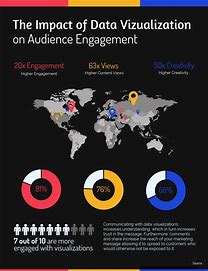Data visualization is an essential component in a society where information is abundant because it may successfully direct us toward making well-informed judgments. By using data visualization tools and methodologies, we may extract useful information that aids in problem-solving for both individuals and enterprises. The following ten data visualization methods are ones you should be aware of:
Interactive Visualizations: Real-time data exploration and interaction are made possible by interactive data visualizations, which also aid in improving user comprehension. It’s more than just a still picture. To obtain more information from an interactive visualization, we can click, hover over, or otherwise interact with it. They frequently include features like drill-down menus, filters, and tooltips. Based on the insights we have from using it, interactive data visualization assists us in making more informed decisions.
Artificial Intelligence: To automate the data visualization process, individuals are turning to artificial intelligence and machine learning these days. People can study large data sets and create intricate models that employ natural language processing (NLP) and data mining skills when AI and data visualization are combined. AI also makes recommendations for appropriate visualizations depending on the context and material.
Virtual reality (VR) and augmented reality (AR): AR and VR technologies are being utilized to provide immersive data visualizations, especially in the training, education, and gaming industries. 360-degree virtual environments are a useful tool for data scientists to build realistic and incredibly accurate models of complex datasets. Multiple data dimensions can be included in these models, which facilitates comprehension for average individuals. Similar to this, augmented reality (AR) is employed to improve real-world encounters with digital information and visualize data. These methods can offer a special method for examining intricate data.
Infographics: Infographics and data art combine creative design with data visualization. It functions similarly to a visual aid for explaining complicated ideas or concepts to others. Infographics consist of brief graphs, charts, and eye-catching text accompanied by images. To convey messages that are powered by facts, they frequently employ imaginative and eye-catching components. It improves the attractiveness and comprehension of the information or message.
Streamgraphs: A type of stacked area graphic used to show how data has changed over time. When you have several sets of data that overlap or stack on top of one another, it’s useful. It represents each dataset using colorful layers as opposed to conventional lines or bars. To illustrate how the data evolves, each layer begins at a similar baseline and travels up and down. In this approach, you can quickly and visually monitor how various data sets change over time.
Real-time Dashboards: A real-time dashboard displays data that is updated in real-time, much like a live report. It displays current information and is simultaneously visible to a large number of users. With its up-to-date information, it’s helpful for tracking data that is always changing, such as stock prices or website traffic. Dashboards that continuously refresh are becoming more widespread as real-time data becomes more accessible. These dashboards find application in domains such as social media monitoring, IoT, and finance.
Data storytelling: Creating narrative-driven dashboards that lead the user through the data is known as data storytelling. Data dashboards that tell stories make data easier to comprehend and extract insights from. These methods contribute to the relatability and engagement of data.
Small Multiple Visualizations: To compare several datasets or time periods, a grid of tiny, comparable charts or graphs is created. They aid with the rapid identification of distinctions and patterns.
Data sonification: It is a technique that involves utilizing sound to represent data. While data visualization uses visual cues to help you understand information, data sonification uses auditory cues to do the same thing. It’s a new method that has potential for helping those who are visually impaired communicate information.
Explanatory Data Visualization: This type of data visualization aims to lead the user through the data and provide a concise, intelligible explanation of the insights. In journalism and data-driven storytelling, they are frequently utilized.









